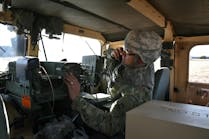Enstrom selects L-3 Trilogy electronic standby instrument for flagship 480B helicopter
LAS VEGAS, 26 Oct. 2013. Officials at Enstrom Helicopter Corp. have selected the Trilogy ESI-2000 electronic standby instrument from L-3 Aviation Products (AP) as an additional safety feature option for the 480B helicopter platform.
“The Trilogy ESI complements the new Enstrom glass panel by mirroring the layout of the primary display,” says Ralph DeMarco, vice president of sales and marketing for L-3 Aviation Products. “This translates into increased safety in the event of a primary failure, helping the pilot easily transition to a familiar layout of critical flight data. With an excellent safety record, Enstrom owners and operators can enjoy even greater peace of mind with the Trilogy standby.”
The Trilogy ESI-2000 advanced solid-state standby instrument makes the all-glass cockpit possible, replacing the three analog standbys that normally accompany glass avionics, according to a company representative. Trilogy provides attitude, altitude, airspeed, and optional heading data on a clear, 3.7-inch digital screen.
By presenting flight information in an easy-to-scan layout that mirrors the primary displays, the instrument facilitates a quick transition to backup flight information in an emergency, while reducing weight and saving panel space, officials say.
Emergency operation of the Trilogy ESI is achieved through the use of high-energy density lithium-ion battery technology. Favorable self-discharge characteristics enable the battery to maintain a charge over long periods of disuse with little to no energy loss, while its power-to-weight ratio provides high output with minimal added mass. Following emergency use, the battery is recharged by the aircraft’s electrical system with no need for removal or inspection. Its maximum capacity is monitored by the ESI computer, which notifies the pilot when replacement is necessary.

Courtney Howard | Executive Editor
Courtney, as executive editor, enjoys writing about all things electronics and avionics in PennWell’s burgeoning Aerospace and Defense Group, which encompasses Military & Aerospace Electronics, Avionics Intelligence, the Avionics Europe conference, and much more. She’s also a self-proclaimed social-media maven, mil-aero nerd, and avid avionics geek. Connect with Courtney at [email protected], @coho on Twitter, and on LinkedIn.



